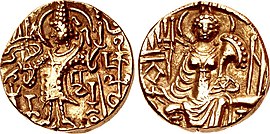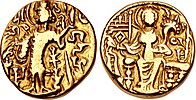Kipunada
Kipunada
Kushan Ruler
Kipunada (Brahmi script: ![]()
![]()
![]()
![]() Ki-pu-ṇa-dha), also Kipanadha, was probably the last ruler of the Kushan Empire around 335-350 CE.[2] He is known for his gold coinage.[3] He succeeded Shaka I. Kipunada was probably only a local ruler in the area of Taxila, in western Punjab, and he may have been a subject of Gupta Emperor Samudragupta.[4]
Ki-pu-ṇa-dha), also Kipanadha, was probably the last ruler of the Kushan Empire around 335-350 CE.[2] He is known for his gold coinage.[3] He succeeded Shaka I. Kipunada was probably only a local ruler in the area of Taxila, in western Punjab, and he may have been a subject of Gupta Emperor Samudragupta.[4]
| Kipunada | |
|---|---|
| Kushan Ruler | |
 Coin of Kipunada. Circa 335-350 CE. Obverse: Kipunada standing left, sacrificing over altar. To the right, name vertically in Brahmi script in monogrammic form: Ki-pu-ṇa Under the ruler's arm: Bacharnatha Reverse: Ardoxsho enthroned facing, holding investiture garland and cornucopia.[1] | |
| Reign | 335-350 CE[2] |
| Predecessor | Shaka I |
| Successor | Kidarites |
The coins of Kipunada in Central and Western Punjab were followed by peculiar coins minted locally in Punjab, with the name "Samudra" on them (Gupta script:![]()
![]()
![]() ), presumably connected to the Gupta Empire ruler Samudragupta.[5][6] Soon after this, coinage was issued in Punjab by Kidarite Hun rulers known as Kirada, Peroz and then the famous Kidara, who occupied the territory formerly held by the Kushans.[5][6][7]
), presumably connected to the Gupta Empire ruler Samudragupta.[5][6] Soon after this, coinage was issued in Punjab by Kidarite Hun rulers known as Kirada, Peroz and then the famous Kidara, who occupied the territory formerly held by the Kushans.[5][6][7]
- Local coin minted in the Punjab area with the name "Samudra" (


 Sa-mu-dra, under the king's left arm), presumably Samudragupta, immediately followed those of Kipunada.[6][5]
Sa-mu-dra, under the king's left arm), presumably Samudragupta, immediately followed those of Kipunada.[6][5]
| Preceded by | Kushan Ruler c. 335-350 CE[2] |
Succeeded by |
- Cribb, Joe; Donovan, Peter (2014). Kushan, Kushano-Sasanian, and Kidarite Coins A Catalogue of Coins From the American Numismatic Society by David Jongeward and Joe Cribb with Peter Donovan. p. 4.
- Heritage World Coin Auctions Long Beach Signature Auction Catalog #378. Ivy Press. May 2005. p. 15. ISBN 978-1-932899-79-5.
- Rezakhani, Khodadad (2017). From the Kushans to the Western Turks. p. 203.
- Cribb, Joe. "The Kidarites, the numismatic evidence.pdf". Coins, Art and Chronology II, Edited by M. Alram et Al.: 101.
- "In the Punjab the stylistic progression of the gold series from Kushan to Kidarite is clear: imitation staters were issued first in the name of Samudragupta, then by Kirada, 'Peroz' and finally Kidara" in Errington, Elizabeth; Curtis, Vesta Sarkhosh (2007). From Persepolis to the Punjab: Exploring Ancient Iran, Afghanistan and Pakistan. British Museum Press. p. 88. ISBN 978-0-7141-1165-0.
- Rezakhani, Khodadad (2017). ReOrienting the Sasanians: East Iran in Late Antiquity. Edinburgh University Press. p. 85. ISBN 978-1-4744-0030-5.
This biography of a member of an Asian royal house is a stub. You can help Wikipedia by expanding it. |

